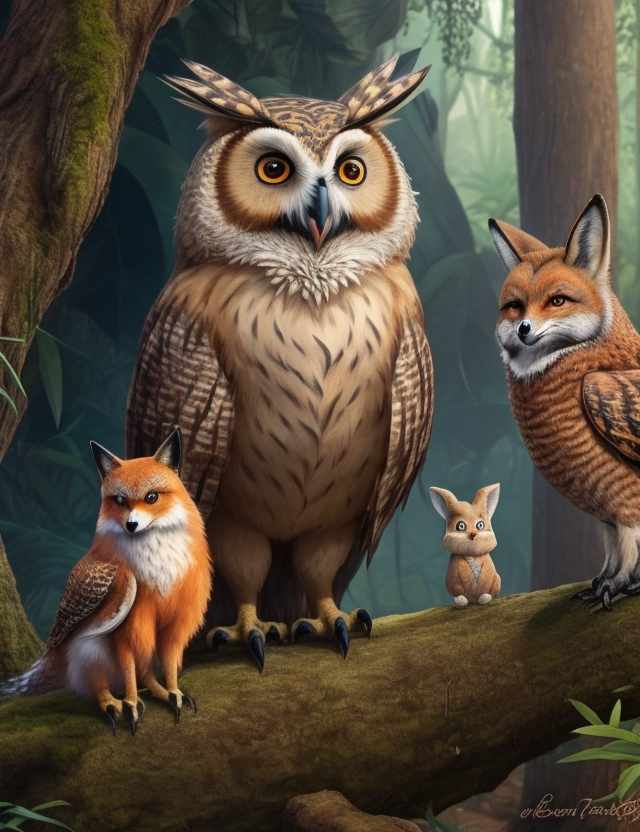
In a vast and enchanting forest, sunlight filtered through the lush green canopy, casting a warm glow on the forest floor. The air was filled with the soothing sounds of rustling leaves and gentle chirping of birds. A diverse group of animals called this forest home, living together in peace and harmony.
At the heart of the forest stood an ancient oak tree, its branches spreading wide to provide shade and shelter. Perched atop the highest branch was Wise old Owlbert, the revered leader of the animal community. With his wise and compassionate nature, Owlbert guided the animals and taught them the value of treating others with kindness.
Under Owlbert's guidance, the animals had learned to respect one another's differences and live as a unified community. From the majestic deer to the tiny ladybugs, each animal played a unique role in maintaining the delicate balance of the forest. They understood that kindness and empathy were the foundations of their peaceful coexistence.
The animals gathered around Owlbert as he addressed them, his voice carrying the weight of wisdom acquired over many years. He spoke of the importance of the golden rule - treating others with kindness as you would like to be treated. Owlbert emphasized that every creature, regardless of its size or species, deserved respect and compassion.
The animals listened intently, their eyes shining with understanding. They shared stories of times when they had shown kindness to one another, recounting how those acts of compassion had created a sense of belonging and unity within the forest. They understood that by treating others with kindness, they not only nurtured a peaceful environment but also fostered a deep sense of happiness within themselves.
As the animals dispersed, they carried with them the lessons from Owlbert's teachings. They ventured into the forest, ready to spread kindness and create a harmonious environment. From the graceful fox to the playful squirrel, each animal was determined to live by the golden rule and contribute to the collective well-being of the forest.
The Peaceful Forest stood as a testament to the power of kindness and empathy. It was a place where differences were celebrated, conflicts were resolved with compassion, and every creature felt valued and supported. The animals knew that as long as they continued to live by the golden rule, the forest would remain a sanctuary of love and harmony.
In a vast and enchanting forest, sunlight filtered through the lush green canopy, casting a warm glow on the forest floor. The air was filled with the soothing sounds of rustling leaves and gentle chirping of birds. A diverse group of animals called this forest home, living together in peace and harmony.
At the heart of the forest stood an ancient oak tree, its branches spreading wide to provide shade and shelter. Perched atop the highest branch was Wise old Owlbert, the revered leader of the animal community. With his wise and compassionate nature, Owlbert guided the animals and taught them the value of treating others with kindness.
Under Owlbert's guidance, the animals had learned to respect one another's differences and live as a unified community. From the majestic deer to the tiny ladybugs, each animal played a unique role in maintaining the delicate balance of the forest. They understood that kindness and empathy were the foundations of their peaceful coexistence.
The animals gathered around Owlbert as he addressed them, his voice carrying the weight of wisdom acquired over many years. He spoke of the importance of the golden rule - treating others with kindness as you would like to be treated. Owlbert emphasized that every creature, regardless of its size or species, deserved respect and compassion.
The animals listened intently, their eyes shining with understanding. They shared stories of times when they had shown kindness to one another, recounting how those acts of compassion had created a sense of belonging and unity within the forest. They understood that by treating others with kindness, they not only nurtured a peaceful environment but also fostered a deep sense of happiness within themselves.
As the animals dispersed, they carried with them the lessons from Owlbert's teachings. They ventured into the forest, ready to spread kindness and create a harmonious environment. From the graceful fox to the playful squirrel, each animal was determined to live by the golden rule and contribute to the collective well-being of the forest.
The Peaceful Forest stood as a testament to the power of kindness and empathy. It was a place where differences were celebrated, conflicts were resolved with compassion, and every creature felt valued and supported. The animals knew that as long as they continued to live by the golden rule, the forest would remain a sanctuary of love and harmony.
Summary of Chapter 1: In a vibrant forest, a diverse group of animals lived harmoniously. They believed in the golden rule of treating others with kindness. Wise old Owlbert, the leader of the animals, taught them the importance of empathy and compassion for all creatures, big and small.
The moral of "The Peaceful Forest" is to highlight the value of harmony and respect for nature and all living beings. The story emphasizes the importance of preserving the natural world and maintaining a peaceful coexistence with the animals and plants that inhabit it. It teaches children the significance of taking care of the environment, showing kindness to animals, and appreciating the beauty and serenity of nature. By promoting an understanding of the interconnectedness of all living things, the moral encourages children to become stewards of the Earth, fostering a sense of responsibility and care for the world around them
Chapter 2: The Lost Fawn
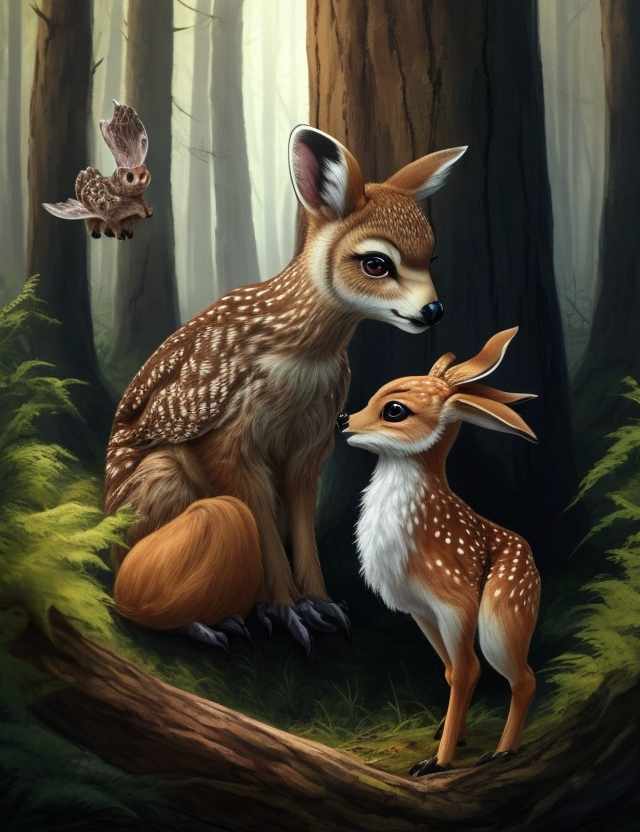
In the heart of the peaceful forest, a gentle breeze whispered through the trees, carrying the scent of wildflowers. The animals went about their daily routines, enjoying the harmony that surrounded them. But one day, a sense of worry filled the air as news spread of a lost fawn.
The fawn, named Bella, had wandered too far from her mother and found herself alone and frightened. Her small hooves trembled as she navigated through unfamiliar terrain, her soft cries echoing through the forest.
Word of the lost fawn reached the animal community, stirring a deep sense of empathy within them. Animals from all corners of the forest gathered to lend a helping paw, wing, or hoof. Wise old Owlbert called for a meeting, urging the animals to work together to find the lost fawn and reunite her with her mother.
The animals formed search parties, each group taking a different path to cover as much ground as possible. The deer used their keen sense of smell to follow Bella's trail, while the birds soared above the treetops, scanning the forest for any sign of her. The small rodents scurried through the underbrush, leaving no stone unturned.
Hours turned into days as the animals tirelessly searched for Bella. They faced challenges along the way, from treacherous terrain to encounters with other forest creatures, but their determination to help the lost fawn never wavered.
Finally, on the third day of their search, a squirrel named Sammie discovered tiny hoof prints near a babbling brook. Excitement rippled through the group as they followed the tracks, leading them to a clearing where Bella stood, weak and frightened.
With gentle coaxing, the animals guided Bella back to the oak tree where her mother anxiously awaited her return. The mother deer nuzzled Bella, her eyes filled with relief and gratitude. The forest reverberated with joyous sounds as the animals celebrated the successful reunion.
In the aftermath of this remarkable rescue, the animals reflected on their collective effort. They realized that their willingness to put aside personal interests and work together had made the rescue possible. It was a testament to the power of kindness, teamwork, and the golden rule in action.
Bella's story touched the hearts of all who witnessed it. The animals felt a renewed sense of unity and compassion, understanding that their actions could change lives and bring immense joy. They pledged to continue living by the golden rule, always ready to lend a helping hand to those in need.
Summary of Chapter 2 One day, a young and frightened fawn named Rosie wandered into the forest. The animals welcomed her with open arms, comforting her and showing her kindness. They understood that Rosie needed their support, and they became her new family.
Moral of the Story:
The moral of "The Lost Fawn" is to emphasize the importance of empathy and compassion. The story highlights how treating others with kindness and understanding can make a significant impact on their lives. It encourages children to reach out and help those in need, even if it requires going out of their way. By demonstrating empathy and compassion, they can bring comfort, support, and a sense of belonging to those who feel lost or alone. The moral teaches children to treat others as they would like to be treated, fostering a world where empathy and kindness prevail.
Chapter 3: A Helping Trunk
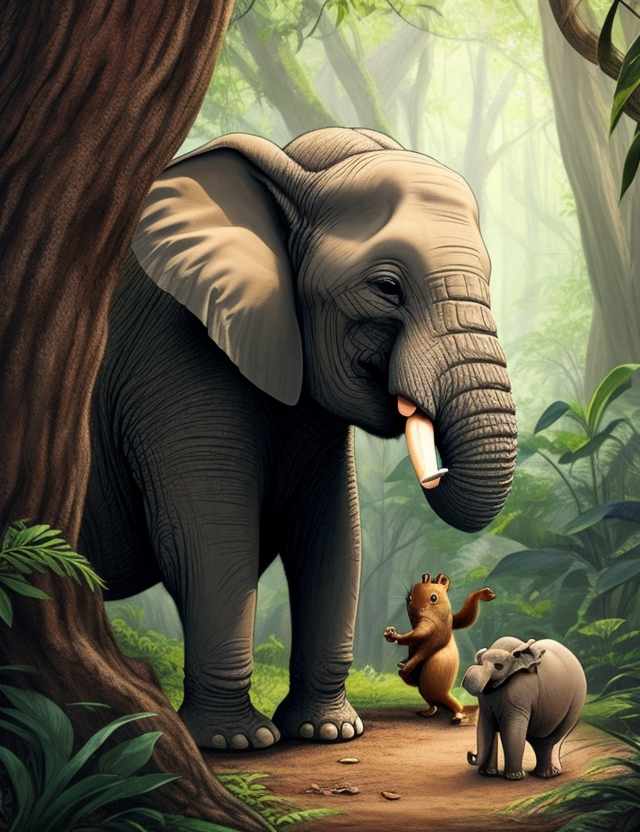
In the heart of the peaceful forest, a spirit of camaraderie and kindness enveloped the animal community. They had witnessed the power of the golden rule in action during Bella's rescue, and this newfound unity continued to inspire them. In this chapter, a heartwarming story unfolds, centered around an unlikely friendship between Eleanor, the wise old elephant, and a young squirrel named Oliver.
Oliver had always admired Eleanor, with her graceful gait and wise eyes that seemed to hold a universe of knowledge. One day, while gathering acorns near the edge of the forest, Oliver stumbled upon a deep ravine. Fear coursed through his tiny body as he realized he couldn't climb out of the steep pit.
His cries for help echoed through the trees, catching the attention of Eleanor. The wise old elephant, with her enormous frame and strong trunk, hurried towards the distressed squirrel. Without hesitation, Eleanor extended her long trunk down into the ravine, offering Oliver a lifeline.
Oliver clung tightly to the trunk, his heart pounding with gratitude and relief. With a gentle tug, Eleanor effortlessly lifted Oliver out of the ravine, placing him safely on the ground. Oliver thanked Eleanor profusely, overwhelmed by her kindness and strength.
This act of friendship between Eleanor and Oliver resonated deeply with the other animals. They gathered around, witnessing the extraordinary display of compassion and the importance of lending a helping trunk, or paw, in times of need. The animals marveled at how Eleanor used her immense power for the benefit of a tiny squirrel, embodying the essence of the golden rule.
From that day forward, Eleanor and Oliver became inseparable friends. They spent their days exploring the forest together, sharing stories and laughter. Oliver eagerly soaked in Eleanor's wisdom, while Eleanor found joy in Oliver's youthful energy and curiosity.
Their friendship extended beyond their own companionship. Inspired by Eleanor's example, the animals started looking out for one another in new ways. They offered assistance, comforted those in distress, and found joy in helping others, just as Eleanor had done for Oliver.
Summary of Chapter 3: When Ellie, the kind-hearted elephant, noticed a family of squirrels struggling to gather food for the winter, she used her long trunk to reach the highest branches and gather an abundance of nuts. She shared her findings with the squirrels, demonstrating the power of selflessness and generosity.
Moral of the story :
The moral of "A Helping Trunk" is to teach the value of lending a helping hand to others in need. The story showcases the importance of kindness, generosity, and empathy. It emphasizes the idea that small acts of assistance can have a significant impact on someone's life. By showing compassion and offering help, children can make a positive difference and create a sense of community. The moral encourages children to be aware of the needs of others and to actively seek opportunities to offer their support and assistance, fostering a culture of kindness and empathy in their interactions with others.
Chapter 4: The Grateful Rabbit
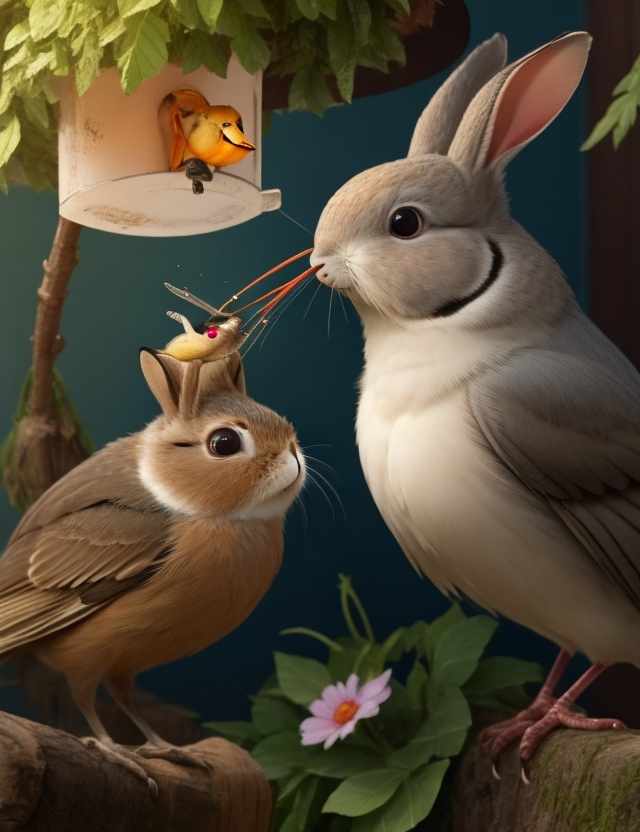
In the heartwarming continuation of "The Golden Rule: Treating Others with Kindness," Chapter 4 introduces us to a humble rabbit named Rosie and explores the theme of gratitude and the lasting impact of a kind gesture.
Rosie, known for her gentle nature and playful spirit, was a beloved member of the forest community. She hopped from meadow to meadow, spreading joy with her infectious energy. One sunny day, as she was nibbling on a patch of clover, she noticed a young bird struggling to build a nest high up in a tall tree.
With her keen sense of empathy, Rosie could sense the bird's frustration and decided to offer her help. She hopped up to the tree and gently suggested alternative ways to build a sturdy nest, using twigs and leaves from the forest floor. The grateful bird eagerly listened and followed Rosie's guidance.
Together, they worked tirelessly, weaving twigs and arranging leaves until the bird had a cozy nest to call home. The bird chirped with delight, expressing her gratitude to Rosie for her invaluable assistance. Rosie's heart swelled with happiness, knowing that she had made a positive difference in someone's life.
News of Rosie's selfless act spread throughout the forest, and soon, the animals began to see the true power of gratitude. They witnessed how Rosie's kindness had touched the bird's heart and created a ripple effect of appreciation within the community. Inspired by Rosie's actions, animals of all sizes started expressing their gratitude to one another, recognizing and acknowledging the contributions and support they received.
The forest became alive with a chorus of gratitude. Squirrels thanked birds for their beautiful songs, while rabbits expressed their appreciation for the shelter provided by burrowing owls. From the tiniest insects to the majestic deer, every creature found ways to show their gratitude, fostering an atmosphere of harmony and appreciation.
Chapter 4 Summary: Rusty, a rabbit with a broken leg, was struggling to find food. Gracie, the clever squirrel, noticed his plight and started collecting and storing extra nuts for him. Rusty was overwhelmed with gratitude and learned the importance of helping others, no matter the circumstances.
Moral of the story : The moral of "The Grateful Rabbit" is to highlight the significance of gratitude and appreciation. The story emphasizes the importance of acknowledging and expressing gratitude for the help and kindness received from others. It teaches children the value of recognizing and valuing the efforts made by others to assist them. By expressing gratitude, children not only show their appreciation but also strengthen the bond of friendship and create a positive and supportive environment. The moral encourages children to be thankful for the acts of kindness they experience and to cultivate a grateful attitude, fostering a culture of appreciation and goodwill in their relationships with others.
Chapter 5: The Healing Songbird
In the enchanting continuation of "The Golden Rule: Treating Others with Kindness," Chapter 5 delves into a tale of compassion and the transformative power of music. The forest community finds themselves facing a difficult situation that will require unity, understanding, and the healing touch of a special songbird.
One gloomy morning, a mysterious sadness settled over the forest. The usually cheerful animals noticed that their fellow creatures appeared downcast and dispirited. No one could pinpoint the cause of this collective sorrow, and a sense of unease permeated the air.
Amidst the somber atmosphere, a small and delicate songbird named Melody fluttered through the forest. Melody possessed a unique gift—the ability to communicate through her melodic tunes. As she noticed the despondent animals, her heart filled with empathy, and she knew she had to do something to lift their spirits.
Perched on a branch, Melody began to sing a sweet, soothing melody that resonated through the trees. Her song carried with it a deep sense of compassion, touching the hearts of all who heard it. The music seemed to wrap around the animals like a warm embrace, lifting their spirits and bringing a glimmer of hope.
One by one, the animals gathered around Melody, their eyes glistening with tears of gratitude. They realized that Melody's healing song had touched their souls and reminded them of the power of kindness and unity. Inspired by the songbird's selfless act, the animals embraced one another, offering words of encouragement and support.
As the forest community basked in the harmony of Melody's music, they realized that they were stronger together. They vowed to approach challenges with empathy and to be there for one another in times of need. The healing songbird had not only brought joy but had also awakened a sense of unity that would forever shape their interactions.
From that day forward, the forest resounded with the echoes of kindness and understanding. The animals nurtured their relationships, valuing the uniqueness and contributions of each individual. They found solace in knowing that the power of compassion could heal wounds, bridge divides, and strengthen their bonds.
Summary of Chapter 5:

In a hidden part of the forest, a songbird named Melody had lost her voice due to sadness. The animals gathered around her, singing soothing melodies and comforting her with their presence. Their unity and compassion helped Melody find her voice again, reminding everyone of the power of support and encouragement.
Moral of the Story:
The moral of "The Healing Songbird" is to emphasize the power of compassion and the healing nature of kindness. The story highlights the impact that a simple act of empathy and support can have on someone who is going through a difficult time. It teaches children the importance of being there for others, offering comfort, and lending a listening ear. By showing compassion and understanding, children can help heal emotional wounds and bring solace to those in need. The moral encourages children to be aware of the struggles of others and to extend a helping hand, spreading kindness and creating a supportive and nurturing environment for everyone around them
Chapter 6: The Forgiving Bear
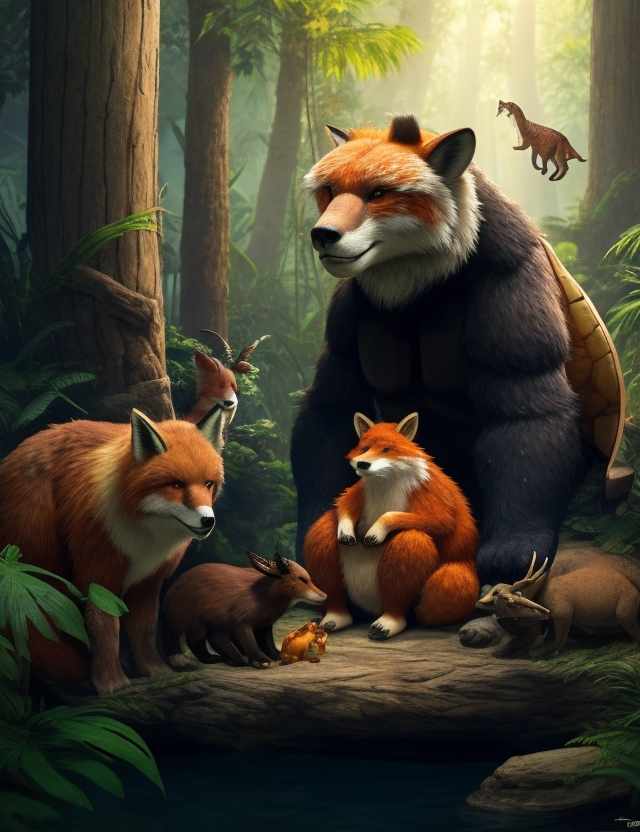
In the captivating continuation of "The Golden Rule: Treating Others with Kindness," Chapter 6 delves into a tale of forgiveness and the profound impact it can have on individuals and the community as a whole. The forest community faces a situation that challenges their unity, but through the power of forgiveness, they discover the path towards healing and harmony.
One sunny afternoon, tensions rose among the animals in the forest. Misunderstandings and disagreements led to hurtful words and strained relationships. The once-close-knit community found itself divided, with animosity clouding the air. The harmony they had cherished seemed like a distant memory.
In the midst of this turmoil, a wise and gentle bear named Benjamin observed the growing rift among his forest companions. Recognizing the destructive power of anger and resentment, he decided to take matters into his own paws and guide the community towards forgiveness.
Benjamin called for a gathering, inviting all the animals to a peaceful clearing where they could share their grievances openly and honestly. With patience and understanding, he listened as each animal expressed their frustrations and pain. Through this open dialogue, the depth of their shared emotions became apparent, and the seeds of empathy began to sprout.
Benjamin, embodying the spirit of forgiveness, spoke from his heart, emphasizing the importance of letting go of grudges and finding understanding in one another's perspectives. He shared stories of his own past mistakes and the healing power of forgiveness that had transformed his life.
As his words echoed through the clearing, a sense of introspection settled upon the animals. They realized that holding onto anger and resentment only perpetuated their pain and hindered the growth of their community. Inspired by Benjamin's wisdom and vulnerability, they chose the path of forgiveness.
One by one, the animals approached each other, offering sincere apologies and embracing the opportunity to start anew. They discovered the immense strength that comes from embracing forgiveness and recognizing the inherent worth of every individual. The weight of past grievances lifted, and a newfound sense of unity blossomed among the once-divided forest inhabitants.
The community celebrated their reconciliation with a feast, sharing stories, laughter, and a renewed appreciation for the power of forgiveness. The forest once again echoed with the sounds of harmony and understanding, as the animals embraced the golden rule with renewed vigor.
Summary of Chapter 6: Benny, a clumsy bear, accidentally broke Sara the squirrel's favorite acorn necklace. Instead of becoming angry, Sara forgave him, understanding that mistakes happen. Benny felt remorse and decided to make it up to Sara by building her a beautiful acorn-shaped house, showcasing the beauty of forgiveness and second chances.
The moral of "The Forgiving Bear" is to highlight the transformative power of forgiveness and the importance of letting go of grudges. The story emphasizes that holding onto anger and resentment only weighs us down and prevents us from experiencing true happiness and peace. It teaches children the value of forgiveness, not only towards others but also towards themselves. By choosing to forgive, children can free themselves from negativity, foster understanding, and promote reconciliation. The moral encourages children to embrace forgiveness as a way to build healthier relationships, promote emotional well-being, and create a more harmonious and compassionate world.
Chapter 7: The Kindness Challenge
.jpg)
In the enchanting continuation of "The Golden Rule: Treating Others with Kindness," Chapter 7 embarks on an exciting journey of spreading kindness throughout the forest and beyond. The forest animals, inspired by their newfound unity and the power of forgiveness, embrace a challenge that will not only touch the lives of those they encounter but also ignite a chain reaction of compassion and goodness.
It all begins on a radiant morning when a colorful bird named Mia flies into the forest with a special message. Mia tells the animals about the Kindness Challenge, an opportunity for them to extend their kindness to the neighboring communities and make a positive difference in the world.
Eager to participate, the animals gather around Mia, their eyes shining with anticipation. Mia explains that they will form teams, with each team assigned a different village or habitat outside the forest. The goal is to perform acts of kindness that resonate with the unique needs and challenges of each place.
The forest inhabitants form teams, combining their diverse skills and talents to maximize their impact. Benjamin the Bear, known for his wisdom, becomes the team leader, guiding them with his compassionate spirit. Bobby the Beaver brings his building expertise, Remy the Rabbit contributes his quick wit and problem-solving abilities, and Lily the Squirrel shares her agility and resourcefulness.
With their teams formed, the animals embark on their respective journeys. Each team sets out with a mission to spread kindness in their assigned community, addressing the specific needs they discover along the way. They engage in various acts of kindness, from helping to rebuild homes damaged by a storm to organizing food drives for the less fortunate.
As the animals carry out their acts of kindness, they witness the transformative power of their actions. Smiles light up the faces of those they help, and a ripple of gratitude spreads throughout the communities they touch. The forest animals find fulfillment in knowing that their efforts are making a positive impact on the lives of others.
Along their journey, the animals encounter challenges and setbacks, testing their resilience and determination. Yet, they persist, fueled by the understanding that even a small act of kindness can have far-reaching effects. They learn the value of perseverance and the importance of staying committed to their mission, no matter the obstacles they face.
As the teams complete their kindness missions and return to the forest, they gather to share their experiences. Their stories of the lives they touched and the joy they spread inspire others to join the cause of kindness. The forest community celebrates their accomplishments, recognizing that their collective efforts have made the world a better place.
Summary of Chapter 7:The animals discovered a pond where a group of frogs felt excluded because they were different. The forest creatures organized a gathering where they celebrated the uniqueness of each frog, embracing diversity and teaching others that kindness knows no boundaries.
The moral of "The Kindness Challenge" is to highlight the transformative power of kindness and the positive impact it can have on individuals and communities. The story emphasizes the importance of going beyond small acts of kindness and embracing a larger challenge to spread kindness to others. It teaches children the value of empathy, compassion, and selflessness in making the world a better place. By actively seeking opportunities to be kind and helping others, children can create a ripple effect of goodness and inspire others to do the same. The moral encourages children to take on the kindness challenge and become agents of positive change, fostering a culture of kindness, empathy, and understanding in their interactions with others.
Chapter 8: The Sheltered Tortoise

In the enchanting world of "The Golden Rule: Treating Others with Kindness," Chapter 8 takes us on a heartfelt journey with Toby the Tortoise, a gentle and shy creature who discovers the power of stepping out of his shell and embracing new experiences.
Toby has always been known for his cautious nature. He spends most of his time nestled within the safety of his shell, observing the world around him with curious eyes. While his fellow forest animals engage in playful adventures and explore new territories, Toby prefers to stay within the familiar surroundings of his cozy burrow.
One sunny day, as Toby peeks out from his shell, he notices a group of animals gathering near a tree. Curiosity gets the better of him, and he musters the courage to venture out of his burrow and approach the lively scene. To his surprise, the animals are discussing the need for a shelter to protect them during storms and harsh weather conditions.
Feeling a sense of empathy for his fellow creatures, Toby realizes that his cautious nature might be an asset in helping them. With his sturdy shell and innate ability to sense danger, Toby proposes the idea of creating a shelter together. The animals are intrigued by his suggestion and eagerly agree to collaborate on this important project.
Toby takes charge, using his meticulous planning skills to organize the construction of the shelter. The animals work tirelessly, each bringing their unique abilities to the table. Benjamin the Bear uses his strength to gather materials, while Emily the Elephant lends her size and dexterity in shaping the structure. Remy the Rabbit utilizes his speed to gather supplies, and Sammy the Squirrel brings his resourcefulness in finding the perfect spots for storage.
As the shelter takes shape, Toby's confidence blossoms. He surprises himself with his newfound leadership skills, guiding the animals with patience and encouragement. Along the way, he forms deep bonds with his fellow animal friends, who recognize and appreciate the wisdom and unique perspective he brings to the project.
Once the shelter is complete, the animals gather inside, grateful for their collaborative efforts. Toby's shell becomes a symbol of protection, reminding them of the importance of unity and working together for the greater good. They celebrate their accomplishment with a joyful feast, sharing stories and laughter under the shelter's sturdy roof.
Summary of Chapter 8:
Back in her town, Lily couldn't wait to put her newfound knowledge into practice. She started a kindness club at school, where she encouraged her classmates to embrace the Golden Rule and make a positive difference in the lives of others.
Moral of ther story:
The moral of this chapter is that embracing new experiences and overcoming fears can lead to personal growth and the ability to make a positive impact on others. Children learn the importance of collaboration, recognizing that everyone has unique qualities that can contribute to a shared goal
Chapter 9: The Generous Fox

In the captivating world of "The Golden Rule: Treating Others with Kindness," Chapter 9 introduces us to Freddy the Fox, a clever and generous creature who learns the true meaning of compassion and selflessness.
Freddy the Fox has always been known for his quick thinking and resourcefulness. He uses his cunning nature to survive in the forest, always on the lookout for opportunities that benefit himself. However, one fateful day, as Freddy ventures through the woods, he stumbles upon a young bird named Bella, stranded on a branch, unable to fly.
Bella is frightened and helpless, chirping in distress. Sensing her fear, Freddy's usual instinct for self-preservation fades away, replaced by a deep empathy for the young bird. Without hesitation, he climbs up the tree, carefully navigating the branches, and reaches Bella's side.
Using his nimble paws, Freddy gently lifts Bella and carries her to a nearby nest. He gathers soft leaves and twigs to create a comfortable bed for her. As Bella settles in, her gratitude shines through her bright eyes. She chirps joyfully, expressing her heartfelt thanks to Freddy.
This encounter sparks something within Freddy—a newfound desire to help others without expecting anything in return. He reflects on the happiness he brought Bella and the fulfillment he felt from his act of kindness. Determined to continue making a positive impact, Freddy sets out on a mission to spread generosity throughout the forest.
He begins by assisting other animals in need. Whether it's collecting food for a hungry squirrel, guiding lost rabbits back to their burrows, or even sharing his cozy den with a homeless hedgehog, Freddy becomes known as the generous fox who always lends a helping paw.
Word of Freddy's kindness quickly spreads throughout the forest, inspiring other animals to follow his lead. Creatures of all shapes and sizes start engaging in acts of generosity, creating a ripple effect of compassion and selflessness. The forest becomes a harmonious place where animals support and care for one another.
Freddy's actions not only transform the lives of those he helps but also change him from within. He discovers that true fulfillment comes from giving, and the bonds he forms with his fellow animals deepen as they witness his genuine desire to make a difference.
Summary of Chapter 9:
Years passed, and Lily's legacy of kindness lived on. The town became a community where people treated one another with empathy and compassion. Lily's story inspired generations to follow the Golden Rule, creating a world where kindness prevailed.
The moral of "The Generous Fox" is to emphasize the virtue of generosity and the joy that comes from selfless giving. The story highlights the positive impact that generosity can have on both the giver and the receiver. It teaches children the importance of sharing their resources, time, and talents with others in need. By being generous, children not only make a difference in someone's life but also experience a sense of fulfillment and happiness. The moral encourages children to cultivate a spirit of generosity, to be aware of the needs of others, and to find ways to give and contribute to their communities. It promotes a culture of kindness, empathy, and sharing, creating a more harmonious and compassionate society.
Chapter 10: The Magic Lives On
In the enchanting world of "The Golden Rule: Treating Others with Kindness," Chapter 10 unveils a magical finale where the power of kindness and compassion triumphs over adversity, leaving a lasting impact on the forest and its inhabitants.
As the animals of the forest continue their journey, a sense of unity and harmony has taken root among them. The ripple effect of their acts of kindness and generosity has created a vibrant community where every creature feels valued and supported.
One peaceful day, the forest is bathed in golden sunlight, signaling a special event about to unfold. Whispers of an extraordinary phenomenon spread among the animals, sparking curiosity and excitement. It is said that when the moon reaches its peak, a magical gathering takes place, where the animals' deepest desires are granted.
Amidst the anticipation, the animal friends come together, their spirits brimming with hope and dreams. Each one carries the lessons they have learned on their journey, eager to harness the magic of the moment for the greater good.
As the moon ascends to its zenith, a soft, shimmering glow envelops the forest, casting a spell of wonder and awe. The animals gather around a mystical clearing, where an ancient oak tree stands tall, radiating an ethereal energy.
From the depths of the oak tree, a wise and gentle voice resonates, speaking words of wisdom and guidance. It is the spirit of the forest, a manifestation of the collective consciousness of the animals and their shared values of kindness, empathy, and respect.
The spirit of the forest invites each animal to step forward and share their deepest desire, promising to grant it if it aligns with the principles of love and compassion. One by one, the animal friends express their heartfelt wishes, focusing on ways to spread kindness and make the world a better place.
Freddy the Fox, now known as the generous fox, steps forward with grace and humility. He wishes for an everlasting legacy of generosity, where future generations of animals will continue to embrace the golden rule and treat others with kindness.
As the spirit of the forest hears their wishes, a cascade of sparkling magic descends upon each animal, infusing them with a renewed sense of purpose and a deep connection to the natural world. They are forever linked to the power of compassion and love, carrying it within their hearts and spreading it wherever they go.
With the magic imbued in their spirits, the animal friends embark on a renewed mission to touch the lives of others and foster a world where kindness reigns supreme. They continue to inspire those they encounter, passing on the wisdom and values that have shaped their journey.
As the chapter comes to a close, the animals bid farewell to the mystical clearing, knowing that the magic lives on within them. They walk back into the forest, their steps filled with determination and hope, ready to create a brighter future for themselves and all who inhabit their beloved home.
"The Golden Rule: Treating Others with Kindness" concludes with a message of enduring hope and the reminder that the power of compassion can transform not only individuals but also entire communities. It encourages children to embrace the magic of kindness, carrying it in their hearts and making a positive difference in the world around them.
As the story reaches its final pages, children are invited to reflect on the lessons learned and to nurture the golden rule in their own lives. They are encouraged to be the embodiment of kindness, spreading love, empathy, and compassion wherever their journey takes them.
And so, the magic lives on, forever etched in the hearts of the animal friends and in the minds of young readers, inspiring them to be the change they wish to see in the world.
Summary of Chapter 10:
As time passed, the forest thrived with harmony and unity. The animals lived by the golden rule, treating each other with kindness and respect. Their actions created a ripple effect, spreading kindness throughout the entire forest and reminding everyone that the golden rule is a timeless lesson that should guide their lives.
The moral of "The Magic Lives On" is to remind children of the enduring power of imagination, wonder, and creativity. The story highlights the importance of holding onto the magic that exists within us, even as we grow older. It encourages children to nurture their imagination and to find joy in exploring new possibilities. The moral emphasizes the value of embracing curiosity, embracing the unknown, and allowing oneself to dream and believe in the extraordinary. It encourages children to keep the magic alive by engaging in creative pursuits, seeking inspiration, and embracing a sense of wonder in their daily lives. The story reminds children that the magic of imagination can bring joy, inspiration, and a sense of limitless possibilities, both in their own lives and in the world around them.
Epilogue: A Lesson for All
The animals' commitment to treating others with kindness became renowned beyond the forest. Their story inspired humans to follow their example, reminding people of the importance of empathy, compassion, and the golden rule in creating a better world for all beings, big and small.
Write a comment ...